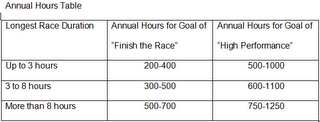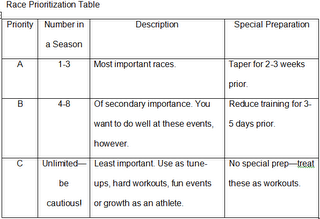Preparing for the 2010 Season, Part 3
Seems like when ever I say 'periodization' someone else says 'rigid' or 'inflexible.' I don't know why that is. I think some people just have a lot of emotional baggage associated with planning and assume the worst. Planning for peak performance is like planning a long car trip. You need a route drawn out on a road map. Along the way you may find some roads closed and so you will detour. Or you might decide to see a point of interest off the planned route. It's doubtful you will follow the planned route with no change. And so it is with periodization. I have never in 30 years of doing this followed a training plan without change. That doesn't mean the plan was wrong or some how bad. It just means that the situation has changed some how. I wrote about this topic about a year ago. If you believe that planning your season is doomed to failure based on something you've read about its rigidity or lack of flexibility please read that post.
Here are the next two steps in laying out your Annual Training Plan (ATP).
At the top of the ATP there is a space to indicate your “Annual Hours.” This is how many cumulative hours you will train over the course of the season including all of your sport-specific workouts (triathletes-swim, bike, run; cyclists-ride; runners-run; etc), weights and cross-training time.
One way to determine annual hours is to look back at how much time you trained in the 2009
 season. You may be able to add 10 to 15 percent onto this number for 2010 if you successfully and easily managed that volume. Another way of estimating annual hours is to determine what your normal training hours are for a week and multiply that by 40. A third option is to base annual hours on your longest race and general goal for that event using the Annual Hours Table.
season. You may be able to add 10 to 15 percent onto this number for 2010 if you successfully and easily managed that volume. Another way of estimating annual hours is to determine what your normal training hours are for a week and multiply that by 40. A third option is to base annual hours on your longest race and general goal for that event using the Annual Hours Table.Step 4: Prioritize Races
Next, on your ATP, write in all of the races you intend to do in the coming season in the column labeled “Races.” Place them on the ATP in the
 appropriate weeks based on their usual dates. For example, let’s say that you have an event scheduled for Saturday, January 30, 2010. It would be listed in the row marked 'Jan 25' since that row includes all the dates from January 25 through January 31. If you have two races the same weekend list them both in that row.
appropriate weeks based on their usual dates. For example, let’s say that you have an event scheduled for Saturday, January 30, 2010. It would be listed in the row marked 'Jan 25' since that row includes all the dates from January 25 through January 31. If you have two races the same weekend list them both in that row. Once you have listed all of your planned events designate each as 'A-priority, 'B-priority,' or 'C-priority' by writing in A, B or C in the 'Pri' column next to the race name using the accompanying Race Prioritization Table.


11 Comments:
You hit the nail on the head! This strategy should be used in anything which involves any form of exercise. I see this all the time in the gym, they only go through the motion of the exercise, not paying attention to monitoring results. In order to increase performance, due diligence has to be exercised whereby you monitor all aspects even right down to your nutritional needs which is often over looked and can greatly effect results. One example (personal experience) which you may find amusing. http://bit.ly/27thrc
Joe, I love your training bible and I have used it exclusively for 7 years. One comment from my experience that might help others:
1. I consider myself more than a "finish the race" guy, but certainly not able to train 1000 hours in a year. I typically have a longer prep and tran periods where I train 7-8 hours a week, but I am able to increase volume and intensity at a level that looks like 500-600 hours for one macrocycle leading into my peak, but at the end of the year I found I've only trained in total 350-400 hours. This is one of the ways I've learned to be more flexible with my season over time. I think the risk of this approach for others is probably a fairly significant increase in volume and intensity from the prep phase into the base phase and it must be done carefully. But, for age group athletes, with limited time and a lot of potential, I don't know how else you could move more to the "serious race goal" without being physically able to train for 1000 hours in a year!
Now, one question. Age group nationals just got moved from August to October, so I'm a year out from my A priority race and I just finished what I thought was my transition period. I'm afraid to start prep and base now and ride that macrocycle out for a year, fearing burn out. From your previous posts I thought maybe I should take another two months of transition. Your thoughts?
Jim McKnight
M30-34 Age Group Triathlete
Jim--You're right, a 1000 hour year doesn't mean doing 20 hours per week for 50 weeks. There are a lot of much lower volume and higher volume weeks that average out to 20. But even then one can play around with the annual volume rates to create a custom hourly plan as you do. There are tables in my Training Bible books that show how to spread one's annual hours out relative to periodization. An experienced athlete can tweak these tables to create something entirely different - and effective.
As for your question, I'd suggest doing an 'A-' priority race in the spring or early summer and your 'A+' race in the fall. That will give you a chance to try out the build and peak process to fine tune how it works for you this season. Things tend to change from year to year for a given athlete. Good luck!
Joe, been reading your books for several years now and have helped me come on from a random trainer to considering studying sports science at uni. A question simular to the one above has cropped up this year though. I've got an A priority race in June so that would leave the 'start' of my season around Jan but I've already done my tranisition for the year, what would you suggest I do until Jan, I was thinking develop my limiter, swimming, but wasn't sure how to train, ie. as if I were in the base period or build?. I'm a triathlete btw. Your advice would be much appreciated
Thanks, Dan
Dan--I usually handle this situation for my clients by having them establish a B+ or A- priority race and then we do a mini-peak for that. Good chance to work out the bugs in your peaking process before the A+ race.
Is it possible that some individuals do not respond well, or need high volume to obtain high performance? I manage 350 hours per year and consider myself pretty competitive (top 10%). Scheduling issues aside, I'm not sure that I could handle more volume. As it is at the end of the season I'm done.
Chad--Yes, it's possible, especially if you do mostly short races.
Hi, i am 17 and have been road cycling for about 5 years. I trained about 500 hours last year and had good results (14th in nationals uk.)So i was wondering if i should increase my hours or stay the same and put more on intensity
Andy
Andy--Well done! At your level of competition intensity is the key to success. That said, you can probably also handle a bit more volume which will contribute to greater endurance if done right. Good luck!
The other question i had was aboutb/c races. In the UK most clubs run weekly time trials and crits, should i do them as hard workouts/races or just focus on a few key races per year.
Most of the locals do them or should they just focus on doing better at less races
Thanks for the reply
Andy
Andy--Wish I could tell you but I can't. There are too many variables. Bottom line is that it's your call.
Post a Comment
<< Home